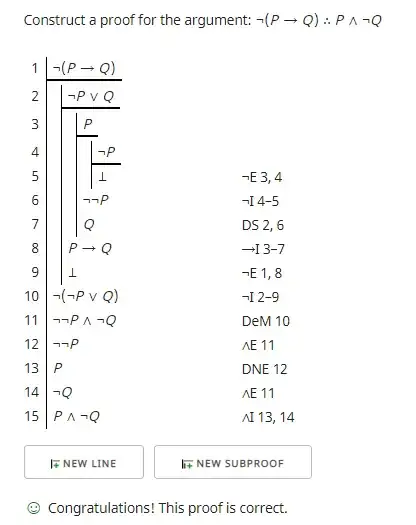I'm trying to solve the following by natural deduction:
~(P → Q) : P & ~Q
It's a trivial problem if identities are used, as can be seen by the following:
{1} 1. ~(P → Q) Prem.
{1} 2. ~(~P ∨ Q) 1 Mat. Impl.
{1} 3. ~~P & ~Q 2 De Morgan's
{1} 4. P & ~Q 3 DNE
Starting from step 2 of the previous proof, it's also fairly straightforward to reach a conclusion using natural deduction; i.e. starting from ~(~P ∨ Q), which is an identity of ~(P → Q):
~(~P ∨ Q) : P & ~Q
{1} 1. ~(~P ∨ Q) Prem.
{2} 2. ~P Assum.
{2} 3. ~P ∨ Q 2 ∨I
{1,2} 4. ~(~P ∨ Q) & (~P ∨ Q) 1,3 &I
{1} 5. P 2,4 RAA
{6} 6. Q Assum.
{6} 7. ~P ∨ Q 6 ∨I
{1,6} 8. ~(~P ∨ Q) & (~P ∨ Q) 1,7 &I
{1} 9. ~Q 6,8 RAA
{1} 10. P & ~Q 5,9 &I
I also found that it's fairly easy to conclude ~Q:
{1} 1. ~(P → Q) Prem.
{2} 2. Q Assum.
{3} 3. P Assum.
{2,3} 4. P & Q 2,3 &I
{2,3} 5. Q 4 &E
{2} 6. P → Q 3,5 CP
{1,2} 7. ~(P → Q) & (P → Q) 1,6 &I
{1} 8. ~Q 2,7 RAA
...
{1,2} 12. P & ~Q
In spite of how easy it looks, I can't figure out how to do it. I believe it can be done in 12 steps. Thanks!
